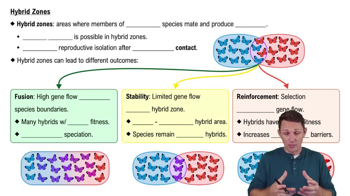Explain why the northern United States experiences a cold season in winter and a warm season in summer?
Table of contents
- 1. Introduction to Biology2h 42m
- 2. Chemistry3h 40m
- 3. Water1h 26m
- 4. Biomolecules2h 23m
- 5. Cell Components2h 26m
- 6. The Membrane2h 31m
- 7. Energy and Metabolism2h 0m
- 8. Respiration2h 40m
- 9. Photosynthesis2h 49m
- 10. Cell Signaling59m
- 11. Cell Division2h 47m
- 12. Meiosis2h 0m
- 13. Mendelian Genetics4h 44m
- Introduction to Mendel's Experiments7m
- Genotype vs. Phenotype17m
- Punnett Squares13m
- Mendel's Experiments26m
- Mendel's Laws18m
- Monohybrid Crosses19m
- Test Crosses14m
- Dihybrid Crosses20m
- Punnett Square Probability26m
- Incomplete Dominance vs. Codominance20m
- Epistasis7m
- Non-Mendelian Genetics12m
- Pedigrees6m
- Autosomal Inheritance21m
- Sex-Linked Inheritance43m
- X-Inactivation9m
- 14. DNA Synthesis2h 27m
- 15. Gene Expression3h 20m
- 16. Regulation of Expression3h 31m
- Introduction to Regulation of Gene Expression13m
- Prokaryotic Gene Regulation via Operons27m
- The Lac Operon21m
- Glucose's Impact on Lac Operon25m
- The Trp Operon20m
- Review of the Lac Operon & Trp Operon11m
- Introduction to Eukaryotic Gene Regulation9m
- Eukaryotic Chromatin Modifications16m
- Eukaryotic Transcriptional Control22m
- Eukaryotic Post-Transcriptional Regulation28m
- Eukaryotic Post-Translational Regulation13m
- 17. Viruses37m
- 18. Biotechnology2h 58m
- 19. Genomics17m
- 20. Development1h 5m
- 21. Evolution3h 1m
- 22. Evolution of Populations3h 53m
- 23. Speciation1h 37m
- 24. History of Life on Earth2h 6m
- 25. Phylogeny2h 31m
- 26. Prokaryotes4h 59m
- 27. Protists1h 12m
- 28. Plants1h 22m
- 29. Fungi36m
- 30. Overview of Animals34m
- 31. Invertebrates1h 2m
- 32. Vertebrates50m
- 33. Plant Anatomy1h 3m
- 34. Vascular Plant Transport1h 2m
- 35. Soil37m
- 36. Plant Reproduction47m
- 37. Plant Sensation and Response1h 9m
- 38. Animal Form and Function1h 19m
- 39. Digestive System1h 10m
- 40. Circulatory System1h 49m
- 41. Immune System1h 12m
- 42. Osmoregulation and Excretion50m
- 43. Endocrine System1h 4m
- 44. Animal Reproduction1h 2m
- 45. Nervous System1h 55m
- 46. Sensory Systems46m
- 47. Muscle Systems23m
- 48. Ecology3h 11m
- Introduction to Ecology20m
- Biogeography14m
- Earth's Climate Patterns50m
- Introduction to Terrestrial Biomes10m
- Terrestrial Biomes: Near Equator13m
- Terrestrial Biomes: Temperate Regions10m
- Terrestrial Biomes: Northern Regions15m
- Introduction to Aquatic Biomes27m
- Freshwater Aquatic Biomes14m
- Marine Aquatic Biomes13m
- 49. Animal Behavior28m
- 50. Population Ecology3h 41m
- Introduction to Population Ecology28m
- Population Sampling Methods23m
- Life History12m
- Population Demography17m
- Factors Limiting Population Growth14m
- Introduction to Population Growth Models22m
- Linear Population Growth6m
- Exponential Population Growth29m
- Logistic Population Growth32m
- r/K Selection10m
- The Human Population22m
- 51. Community Ecology2h 46m
- Introduction to Community Ecology2m
- Introduction to Community Interactions9m
- Community Interactions: Competition (-/-)38m
- Community Interactions: Exploitation (+/-)23m
- Community Interactions: Mutualism (+/+) & Commensalism (+/0)9m
- Community Structure35m
- Community Dynamics26m
- Geographic Impact on Communities21m
- 52. Ecosystems2h 36m
- 53. Conservation Biology24m
48. Ecology
Introduction to Ecology
Problem 2
Textbook Question
Which lake zone would be absent in a very shallow lake?
a. Benthic zone
b. Aphotic zone
c. Pelagic zone
d. Littoral zone
 Verified step by step guidance
Verified step by step guidance1
Understand the characteristics of each lake zone: The benthic zone is the bottom of the lake, the aphotic zone is the part of the lake where sunlight does not penetrate, the pelagic zone is the open water area, and the littoral zone is the nearshore area where sunlight reaches the bottom.
Consider the depth of the lake: A very shallow lake will have limited vertical stratification, meaning that some zones may not be present due to the lack of depth.
Identify the zone that requires depth: The aphotic zone is defined by the absence of sunlight, which typically occurs at greater depths.
Evaluate the presence of sunlight: In a shallow lake, sunlight can penetrate throughout the entire water column, eliminating the possibility of an aphotic zone.
Conclude which zone is absent: Based on the understanding that a shallow lake allows sunlight to reach all areas, the aphotic zone would be absent.
 Verified video answer for a similar problem:
Verified video answer for a similar problem:This video solution was recommended by our tutors as helpful for the problem above
Video duration:
2mPlay a video:
Was this helpful?
Key Concepts
Here are the essential concepts you must grasp in order to answer the question correctly.
Lake Zones
Lake zones are distinct areas within a lake characterized by specific physical and biological conditions. These zones include the littoral zone (near the shore), pelagic zone (open water), benthic zone (lake bottom), and aphotic zone (deep water without light). Understanding these zones helps in identifying the ecological dynamics and species distribution within a lake.
Recommended video:

Hybrid Zones
Aphotic Zone
The aphotic zone is the part of a lake where sunlight does not penetrate, making it devoid of photosynthetic activity. It typically exists in deeper lakes where light cannot reach the bottom. In very shallow lakes, this zone is absent because the entire lake is illuminated by sunlight, allowing photosynthesis throughout.
Recommended video:

Hybrid Zones
Shallow Lake Characteristics
Shallow lakes are characterized by their limited depth, which affects the distribution of light and temperature throughout the water body. These lakes often lack an aphotic zone due to their depth, allowing light to reach the bottom and supporting a diverse range of aquatic plants and organisms. This influences the ecological balance and nutrient cycling within the lake.
Recommended video:
Guided course

Characteristics of Life
Related Videos
Related Practice
Textbook Question
934
views


